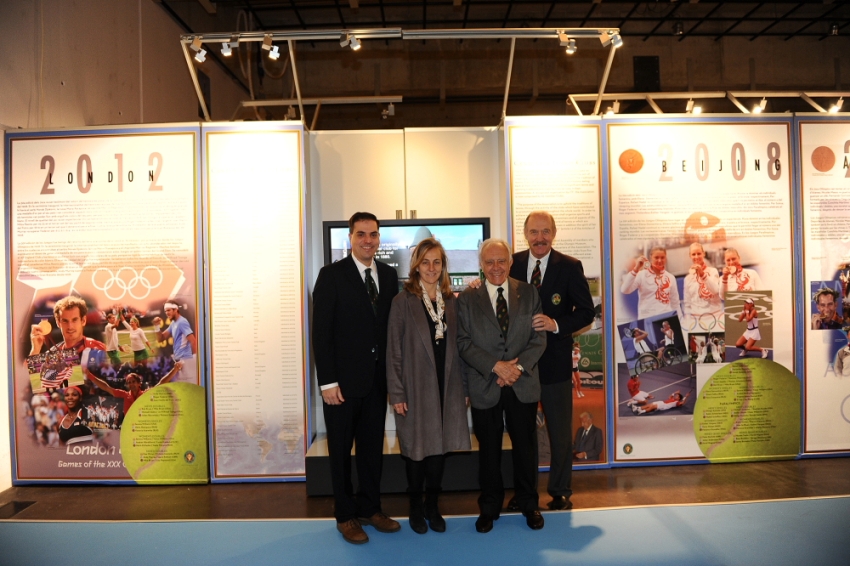NEWPORT, R.I., U.S.A., January 9, 2014 – The International Tennis Hall of Fame & Museum, in partnership with the Barcelona Olympic Foundation, has opened a special exhibition entitled Tennis and the Olympic Games, which is now on display at the Olympic and Sports Museum Joan Antoni Samaranch in Barcelona, Spain. The exhibit will be on display through April 2014 and it is open to the public. Tennis and the Olympic Games offers a comprehensive look at the most successful tennis Olympians in history, and highlights the appeal of tennis as one of the world’s most international sports. It also details the interesting role that tennis has played in the Games, having gone from a full medal sport to having no presence for many years, and back to a full medal, extremely popular sport in the last several decades.
The organizers gathered with media and Spanish tennis industry leaders for an opening ceremony today in Barcelona. The exhibit is made possible through a unique tennis partnership among the International Tennis Hall of Fame & Museum, the Barcelona Olympic Foundation, the Spanish Tennis Federation, and the Real Club de Tenis Barcelona – 1899.
“Tennis is one of the world’s most international sports year-round, but when combined with the spirit of the Olympics, the game’s international nature truly shines. The sport has had a rich history within the Olympic movement, and we are delighted for this unique opportunity to showcase tennis’ role in the Games for the fans who visit the Olympic and Sports Museum,” said Hall of Fame President Stan Smith. “The Hall of Fame’s mission is to preserve and celebrate the rich history of tennis, and we are grateful to the Olympic and Sports Museum of Barcelona, and our partners at the Barcelona Olympic Foundation, the Spanish Tennis Federation, and the Real Club de Tenis Barcelona – 1899 for helping us to share this important part of tennis history with an international audience.”
Smith was a speaker at today’s opening ceremony. Joining Smith at the event was José Luis Escañuela, president of the Real Federación Española de Tenis, M. Teresa Fandos, president of the Fundació Barcelona Olímpica, and Albert Agustí, president of the Real Club de Tenis Barcelona-1899.
Hall of Famers Manuel Orantes and Andres Gimeno came out to support the exhibit opening, as did many players. Among those in attendance were Jordi Arrese, who was a silver medalist at Barcelona 1992, José Higueras, Lis Arilla, Jordi Bardou, and Alex Corretja and Albert Costa, doubles bronze medalists from Sydney 2000.
The exhibit features Olympians from many nations, including a full listing of every Olympic and Paralympic tennis medalist in history. There is special emphasis on Spain’s celebrated players, such as Hall of Famer Arantxa Sanchez-Vicario, Rafael Nadal, Conchita Martinez, and Sergi Bruguera.
Among the highlighted artifacts in the exhibit is a racquet of Andy Murray’s from the 2012 London Games, when he clinched the gold medal before an adoring home crowd at the All England Club. A racquet belonging to London doubles gold medalist Bob Bryan is on display as well.
Highlighting Spain’s great accomplishments in the Games, the exhibit includes memorabilia from Rafael Nadal’s success at Beijing 2008, when he won the gold medal, as well as memorabilia of Arantxa Sanchez-Vicario’s from Atlanta 1996, when she won a silver medal in singles and a bronze in doubles. Spanish players Alex Corretja and Albert Costa contributed their racquets from the 2000 Olympic Games in Sydney when they won the bronze medal. In addition, Sergio Casal’s silver medal from the 1988 Games in Seoul is on display. A particularly interesting item in the exhibit is Spaniard Eduardo Flaquer’s scrapbook and racquet from the 1924 Olympic Games, which was the last year that tennis was a medal sport until 1988.
Fans will be able to read about historic victories, such as Steffi Graf’s 1988 Gold Medal, which made her the first person, and the only person to date, to achieve the Golden Slam (all four majors and the Olympic gold medal in one year). Guests will also take away some interesting tennis facts; for example, who would have guessed that the 1900 champion would have won a coffee and liqueur serving table as his Olympic prize, or that some years there were both indoor and outdoor tennis events contested?
The exhibit also showcases the Paralympic Games, highlighting how eight competitors from five nations showed off their skills at the 1988 Seoul Olympics in a convincing demonstration that propelled wheelchair tennis to a full medal sport at Barcelona in 1992.
Imagery throughout the exhibit showcases great moments from the Games, including the unstoppable Williams sisters, who have captured three gold medals in doubles and one each in singles; the extraordinary wheelchair tennis champion Esther Vergeer, who has won five Paralympic gold medals (3 in singles, 2 in doubles); and the overjoyed Andy Murray, from the moment he captured gold before his home crowd at the Olympics in London in 2012.
The Olympic and Sports Museum Juan Antonio Samaranch is managed by the Barcelona Olympic Foundation. Through changing exhibits and interactive displays, the museum showcases how the qualities of sports transcend all cultures and places special emphasis on the Olympic spirit.
Located in Newport, Rhode Island, USA, the International Tennis Hall of Fame & Museum is a non-profit organization dedicated to preserving the history of tennis, honoring its greatest champions and leaders, and inspiring the future of the sport. The Hall of Fame operates an extensive museum that highlights the history of tennis from its 12th century origins through present-day, as well as the fascinating life stories of the game’s greatest athletes and industry contributors. The museum’s collection features vintage tennis equipment, video highlights and iconic photos, tennis apparel ranging from Victorian dresses to modern fashions, tennis inspired paintings and fine arts, and memorabilia from remarkable moments as recent as the current-year Grand Slams. Changing exhibits and special exhibitions, similar to Tennis and the Olympic Games are displayed year-round in the museum.




